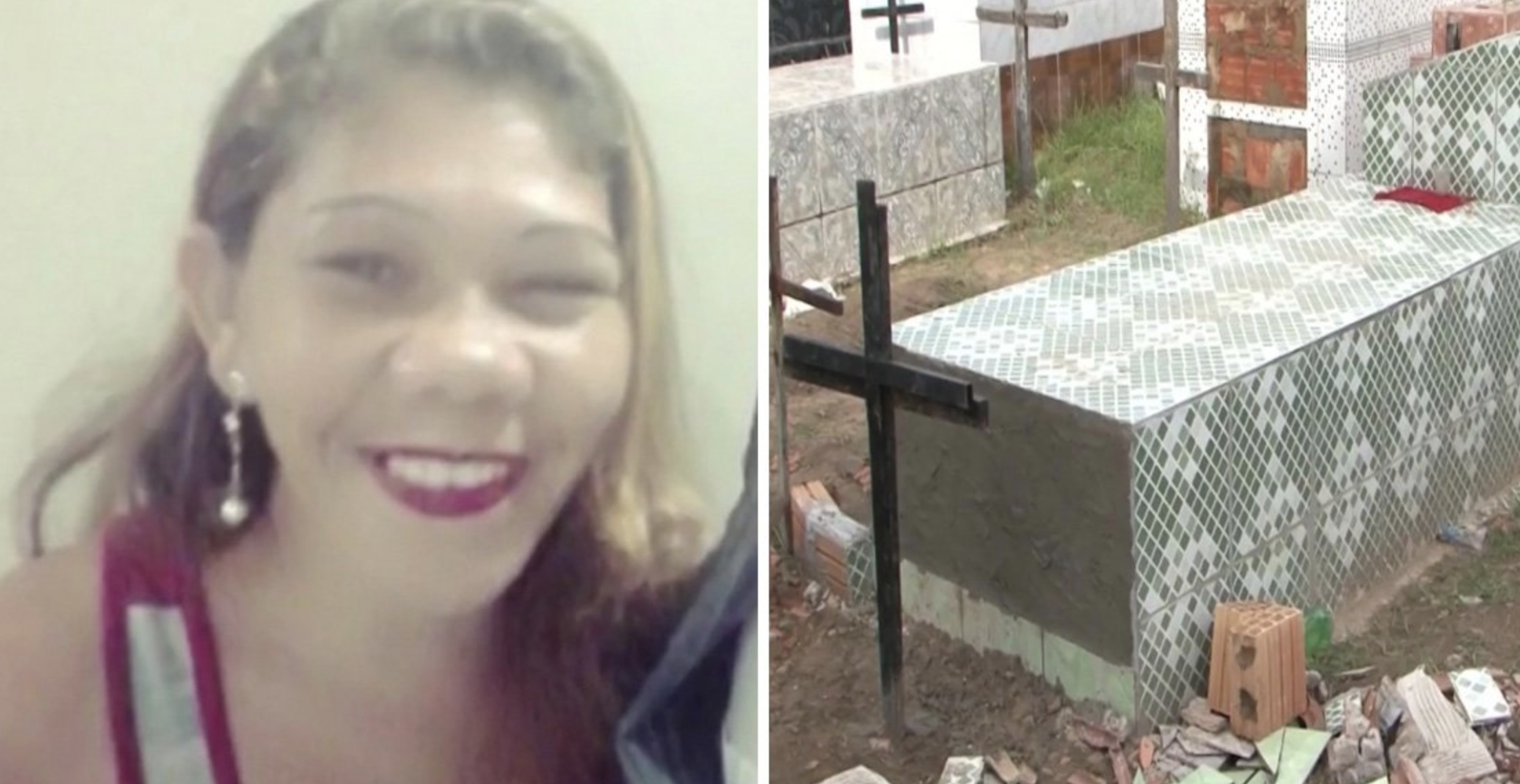Woman Struggles 11 Days To Escape Coffin, Family Claims She Was Mistakenly Buried Alive
In a haunting and puzzling case that has shaken a small community in northern Brazil, one woman struggles 11 days to escape coffin as she was buried alive. The family of Rosangela Almeida, 37, is asserting that she may have been mistakenly buried alive after being declared dead. The disturbing ordeal began in January 2018 when Rosangela was pronounced dead due to septic shock and two heart attacks, as stated on her official death certificate.
Author:Maxwell CanvasReviewer:Black Crystal Aug 18, 202323.9K Shares412.7K Views

In a haunting and puzzling case that has shaken a small community in northern Brazil, one woman struggles 11 days to escape coffinas she was buried alive. The family of Rosangela Almeida, 37, is asserting that she may have been mistakenly buried alive after being declared dead. The disturbing ordeal began in January 2018 when Rosangela was pronounced dead due to septic shock and two heart attacks, as stated on her official death certificate.
However, recent revelations from her family have cast doubt on the accuracy of her death declaration. They are alleging that not only was Rosangela buried prematurely, but she might have been conscious inside her coffin for up to 11 days after her supposed passing. The family's claims have sent shockwaves through their community, leaving many questions unanswered.
Brazil Woman Struggles 11 Days To Escape Coffin
The unsettling series of events started when visitors near the cemetery reported hearing faint banging and even groaning sounds emanating from the stone tomb where Rosangela had been buried in Riachao das Neves.
One witness described their experience, saying:
“„When I got there right in front of the tomb, I heard banging from inside it. I thought the kids who play around the cemetery were playing a joke on me. Then I heard her groan twice, and after those two groans she stopped.- Witness
The family, worried by these stories, hurried to the cemetery and chose to dig up the grave to find answers. The scary moment was caught on video as they lifted the wooden coffin out of the ground.
Video unavailable
This video is unavailable
Surprisingly, the coffin showed signs of injuries on Rosangela's wrists and forehead, and there were traces of blood inside. Also, the nails holding the coffin's lid seemed to have become loose.
Germana de Almeida, a member of the family, remarked:
“„Those nails on top were loose. Her hand was injured.- Germana de Almeida
These injuries were reportedly not present when Rosangela was initially laid to rest, raising concerns about what transpired in the days following her declared death.
Further complicating the situation, witnesses present during the exhumation claimed that the body was not cold to the touch, suggesting that Rosangela might not have been deceased for an extended period.
This observation fueled speculation that she may have been alive when she was placed in the coffin. However, the exact timeline remains uncertain, leaving room for conjecture about the potential tragedy that unfolded.
Despite the family's assertions and the eerie evidence, a police investigation into the matter found that the reports of groans and banging could be dismissed as "rumors." Consequently, those involved in the exhumation faced the possibility of being charged with disturbing a grave, a crime that could carry a sentence of up to three years in prison according to Brazilian law.
Civil authorities eventually concluded that Rosangela had not been buried alive, leaving many questions unanswered and the family's claims invalidated. The case has left the community grappling with uncertainty and disbelief, highlighting the complex intersection of science, culture, and emotion surrounding death and its aftermath.
As the small Brazilian town continues to grapple with this unsettling incident, the tale of Rosangela Almeida serves as a chilling reminder of the fine line between life and death, and the profound impact such cases can have on communities far and wide.
How Often Is Someone Buried Alive?
Instances of individuals being buried alive, though unsettling, occur more frequently than commonly anticipated. Reports and cases from around the world highlight the eerie possibility of premature burials, shedding light on a disconcerting phenomenon that challenges our perceptions of life and death.
Stories Of People Who Were Buried Alive
How often does the unsettling possibility of premature burials emerge? Contrary to our hesitation, such incidents happen more often than one might expect. Cases similar to Montoya's resonate globally.
- In Mumbai, a man was presumed dead after being found unconscious at a bus stop, his body infested with maggots. Medical examination revealed no pulse, leading to his transfer to the mortuary. Surprisingly, he regained consciousness and was later diagnosed with a metabolic disorder requiring hospital care.
- In 2014, a Polish woman amazed mortuary staff by showing vitality within a body bag. The elderly woman returned to her family, seeking comfort in familiar food.
- One of the most remarkable accounts involves Angelo Hays. In 1937, Hays, a Frenchman, suffered a motorcycle accident that slammed his face into a brick wall. Pronounced dead and interred, his body was exhumed due to insurance concerns, revealing him to be alive. Hays' ordeal caused a coma, reducing his need for oxygen. After recovery, he embarked on an extraordinary journey, touring the nation in a self-made coffin.
What Is The Lazarus Effect?
The Lazarus Effect is a medical explanation for the phenomenon of awakening before burial. When cardiac arrest occurs, medical professionals typically declare a patient deceased after administering resuscitation without response. However, exceptions arise where patients unexpectedly regain cardiac activity, virtually returning from the brink of death. Such cases challenge the initial notion of demise.
This phenomenon takes the form of the Lazarus phenomenon or Lazarus syndrome. Clinically known as "autoresuscitation," patients generally regain blood circulation within 10 minutes of CPR, with some awakening hours later.
It's worth noting that survival following the Lazarus phenomenon is brief, with only 18 documented full recoveries among 65 instances reported between 1982 and 2018.
Video unavailable
This video is unavailable
How Does The Lazarus Phenomenon Typically Occur?
The Lazarus phenomenon typically emerges after medical professionals administer CPR. While the exact cause is uncertain, experts speculate that CPR could lead to excessive lung inflation and chest pressure.
This pressure might impede blood circulation to the heart, mimicking cardiac arrest. As the pressure subsides and blood flow resumes, the person seems to awaken, albeit temporarily. While closely monitored, the body's reactions after death or presumed death may vary, sometimes leading to the appearance of revival during funerals.
According to the Cleveland Clinic, this intriguing phenomenon might be more common than documented. Rodney Davies, in his work "The Lazarus Syndrome: Burial Alive and Other Horrors of the Undead" (1998), estimated that 1 to 2 percent of U.S. and European burials could be premature. However, the exact prevalence of such instances remains uncertain.
Could Falling Into A Deep Coma Lead To Accidental Burial?
Considering the possibility of accidental burial, a question arises: If one falls into a deep coma, could circumstances lead to an accidental burial? Is there a risk of being trapped within a casket and one's own mind?
Modern scientific advancements offer a range of tests to differentiate true brain death from a coma:
- Assessing pupil reactivity- When exposed to bright light, a healthy response triggers the contraction of pupils. This vital reaction, however, is notably absent in cases of brain death.
- Ocular stimulation- A simple yet telling test involves gently employing a cotton swab to stimulate the eyeball. The subsequent blinking response is a hallmark of vitality and presence.
- Gag reflex evaluation- By introducing and manipulating a breathing tube within the throat, medical professionals can gauge the presence of a gag reflex. The lack of this reflex serves as an indicator of a deceased state.
- Ice water infusion into the ear canal- A rather unconventional yet effective assessment involves infusing ice water into the ear canal. The absence of rapid eye flickering in response to this stimulus signifies a critical condition.
- Monitoring spontaneous respiration- The cessation of spontaneous breathing upon the removal of a ventilation apparatus serves as a telltale sign of dysfunction in the brain stem, a key indicator of brain death.
- Electroencephalogram (EEG) analysis- Utilizing technology to measure electrical brain activity, this test can distinctly demarcate between a brain-dead individual and one with active brain functions.
- Cerebral blood flow study (CBF)- The utilization of radioactive isotopes facilitates the detection of cerebral blood flow, offering a tangible marker to discern the presence of life.
- Administering atropine IV- The response of heart rate to the administration of atropine through intravenous means provides a valuable clue to the vitality of the individual.
Diagnosing brain death requires multiple test failures, confirmed by multiple medical experts. In the modern context, confirming brain death involves a comprehensive scientific process, far removed from the outdated notion of an individual with a needle poised over the heart, confirming demise.
People Also Ask
Who Was Buried Alive In Ecuador?
A woman named Bella Montoya in Ecuador was buried alive. She was initially declared dead but surprised her family by showing signs of life at her own wake.
Is It Possible To Be Buried Alive?
Yes, it is possible to be buried alive. If someone is buried alive and breathing normally, they are likely to die from suffocation. A person can survive in a coffin with the available air for a little over five hours. If they start hyperventilating due to panic, the oxygen will run out sooner.
Who Was The Woman Alive At Her Own Wake?
Bella Montoya, a woman from Ecuador, revived at her own funeral but has since died. She shocked her relatives by waking up at her own funeral after being declared dead due to a suspected stroke.
What Is The Fear Of Being Buried Alive?
Taphophobia, also known as the fear of being buried alive, is an abnormal phobia. It arises from the fear of being mistakenly pronounced dead and then actually being buried alive.
What Are The Risks Of Being Buried Alive?
Premature burial can lead to death due to various factors, including asphyxiation, dehydration, starvation, and in cold climates, hypothermia.
What Is The Fear Of The Dead Called?
Necrophobia is the specific phobia characterized by an irrational fear of dead organisms, such as corpses, and things associated with death, like coffins, tombstones, funerals, and cemeteries.
How Much Oxygen Is In A Coffin?
In a coffin, there are approximately 820 liters of air. About one-fifth of this air (164 liters) is oxygen. If a trapped person consumes 0.5 liters of oxygen per minute, it would take nearly 5 and a half hours for all the oxygen in the coffin to be consumed.
Conclusion
In the space between life and death, the Lazarus effect presents a puzzling mystery. Stories like the incident where a woman struggles 11 days to escape coffin highlight the deep questions about existence. Despite the uncertainty, human strength endures. Advances in science help us differentiate between life and death, giving us comfort in our knowledge.
The Lazarus effect reminds us that life is full of power and unexpected discoveries. It beckons us to peer into the realm of the unknown, where the line between life and its cessation is hazy yet intriguing. As we navigate the intricacies of our mortality, the Lazarus effect invites us to reflect on the boundless potential that lies within the puzzling threshold between life and what follows.

Maxwell Canvas
Author
Maxwell Canvas, a charismatic and fearless crypto evangelist, defies conventions and blazes a trail in the realm of digital currencies. With his unique physique serving as a symbol of resilience, he challenges societal norms and proves that true expertise transcends appearances. Against a backdrop of a blurred and ever-shifting market, Maxwell's work becomes a masterpiece, painting a vivid picture of knowledge and inspiration.
With unwavering passion, Maxwell empowers others to embrace the transformative potential of blockchain technology. His captivating presence and unyielding dedication captivate audiences, turning skepticism into curiosity and igniting a spark of interest in the world of cryptocurrencies. Maxwell Canvas stands as a visionary force, leaving an indelible mark on the crypto landscape, inspiring others to explore decentralized possibilities and embrace a future of innovation and financial empowerment.

Black Crystal
Reviewer
Black Crystal is a captivating writer who finds inspiration in the quiet corners of the street and the mysterious depths beneath bridges. With a penchant for the night, she crafts enchanting tales that explore the uncharted realms of the human experience. Embracing the darkness as her muse, Black Crystal's evocative prose and haunting imagery transport readers into a world where secrets whisper and dreams take shape.
Her writing defies categorization, inviting readers to uncover the magic hidden within the shadows and embrace the enigmatic beauty of her nocturnal narratives. Step into her realm, where the written word dances with ethereal grace, and immerse yourself in the captivating stories she weaves.
Latest Articles
Popular Articles